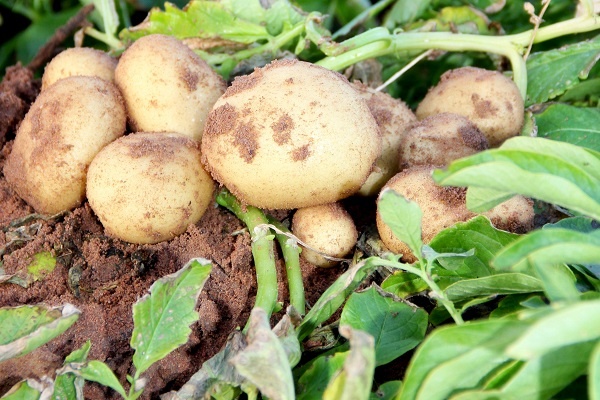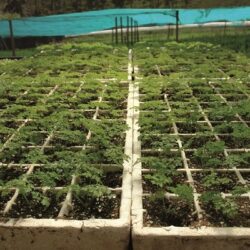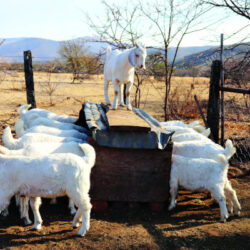We look at the bacterial pathogens that can cause disease in potato plants and tubers.
Yield losses and reduced cosmetic value are 2 of the detrimental effects bacterial diseases can have in the potato industry. Of these, Ralstonia solanacearum (bacterial wilt), Pectobacterium spp, Dickeya spp (previously known as Erwinia spp) and Streptomyces spp (common scab) are the most important in South Africa.
BACTERIAL WILT
- Bacterial wilt, also known as brown rot or vrotpootjie, is a very important disease in potatoes.
- Ralstonia solanacearum causes it, and it’s listed as a quarantine disease in the potato seed industry.
- Early field symptoms are most evident in the heat of day when single stalks on plants show a green wilt.
- The plants often recover at night.
- The bacteria multiply within the vascular tissue, and the time from infection to death is especially rapid for young plants.
- The disease causes a brown discolouration of the vascular tissue which can be seen if the stems, roots or stolons are cut.
- Creamy ooze may discharge from these discoloured parts after a few minutes.
- This is more easily seen if the cut parts are suspended in water.
- Warm, moist conditions favour the development of the disease.
PECTOBACTERIUM AND DICKEYA DISEASES
- Diseases such as blackleg, soft rot and stem rot are caused by Pectobacterium and Dickeya spp.
- These diseases can cause severe yield losses and their importance is often underestimated.
- The main disease symptoms include early dying, reduced emergence, stem rot and soft rot.
BLACKLEG
- This is caused by Pectobacterium carotovorum, subsp brasiliensis, and results in blackening of the potato stems.
- Infection starts with infected seed tubers and soon progresses to the stems.
- In severe cases the plant wilts, yellows and dies.
SOFT ROT
- The main causal agent for soft rot is Pectobacterium carotovorum (previously known as Erwinia carotovora subsp carotovora).
- It can occur in the field as well as in storage.
- Infection starts as brown, watersoaked lesions on tubers and rapidly develops into full-blown tuber rot.
STEM ROT
- Pectobacterium carotovorum and Dickeya spp are the main causes of stem rot.
- The disease is not caused by infection from potato seed but by external factors such as hail, wind, insect damage and cultivation practices.
- It can also be transmitted via rain and irrigation water and results in rotting of the stem.
Control measures:
- plant certified seed;
- rotate crops with non-host crops;
- don’t cut tubers;
- don’t use dip treatments on tubers before planting;
- remove infected plants from the field as soon as possible;
- harvest only mature tubers;
- limit mechanical damage to tubers during harvesting;
- use sanitisers to clean equipment and storage facilities;
- ventilate storage facilities; and
- destroy potato residue after harvesting.
COMMON SCAB
- Scab is an important cosmetic disease of potato tubers.
- Scab-like lesions form on the surface of the potatoes and this reduces tuber quality.
- It is caused by various Streptomyces spp, of which Streptomyces scabiei is the most important.
- Common scab is most severe in sandy soils that have a pH higher than 5.5.
- The symptoms vary.
- Usually, roughly circular, raised, tan to brown, corky lesions of different sizes develop randomly across tuber surfaces.
- Although scab symptoms are generally noticed late in the growing season or at harvest, tubers are susceptible to infection as soon as they form, and the severity increases throughout the growing season.
- Small brown, water-soaked, circular lesions can be seen on tubers within a few weeks of infection.
- Scab is most severe when tubers develop under warm, dry soil conditions.
- Common scab pathogens not only cause disease in potatoes, but also attack the fleshy roots of turnips, radishes, beetroot, carrots, parsnips, mangolds, salsify and rutabaga.
Control measures:
- chemicals: use treatments for soil (quintozene) and tubers;
- plant resistant cultivars;
- plant scab-free tubers;
- rotate crops (on a 4 year cycle) with non-host crops; and
- practise green manuring, using Brassica crops.
Also read:
Seed potatoes – make an informed choice
Potato production: Biology kicks rhizoctonia in the teeth




